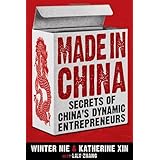
Average Reviews:

(More customer reviews)Are you looking to buy Made in China: Secrets of China's Dynamic Entrepreneurs? Here is the right place to find the great deals. we can offer discounts of up to 90% on Made in China: Secrets of China's Dynamic Entrepreneurs. Check out the link below:
>> Click Here to See Compare Prices and Get the Best Offers
Made in China: Secrets of China's Dynamic Entrepreneurs ReviewThree scholars from IMD made their best attempt to demystify the secret success of POEs (privately-owned enterprises) which have dominated the economic landscape in China.Unlike SOEs (state-owned enterprises, POEs lack sufficient political and financial capital to grow their businesses due to undeveloped banking system (P.167) and policy support from the government (P.39) but they have played a significant role in terms of GDP contribution, fixed asset investment, export volume, fiscal revenue, and employment in China (Pp.48-53).
This book consists of four main parts. Part I describes how three POEs including Wahaha, Nice, and Taoboa can compete in a more fexible and innovative manner than sizeable MNCs such as Danone from France, and P&G and eBay from US. Part II focuses on the development of entrepreneurship in China and how three Chinese entrepreneurs start up and grow their businesses. Part III is an empirical study of twenty small to medium sized POEs (Pp.202-204) including background of founders and their business models. Part IV is an analysis of strengths and weaknesses of POEs and any other potential opportunities and pitfalls for MNCs to collaborate with them while entering the Chinese market.
This book concludes that private entrepreneurship in China is "characteristically Chinese" (P.135) which is heterogeneous to entrepreneurship in the western world. For instance, Chinese entrepreneurs are accustomed to work hard in building and maintaining guanxi (relationship) with key people in the government in order to procure permits and business opportunities. Moreover, Chinese entreprenueurs seldom rely on venture capital or angel investment to start up their businesses but raise start-up capital via relatives or friends.
Nonetheless, this book helps readers to understand why POEs can have a strong market presence in a highly turbulent institutional environment in China. However, the empirical research mainly covers twenty privately-owned enterprises which are small to medium in size. The research findings cannot represent development paths and business models of more admirable and sizeable POEs. For the recent five years, most of them have funded their new businesses via IPO in A-share markets in Shanghai and Shenzhen and H-share market in Hong Kong or procurement of bank loans from local and overseas banks. They have also favored joint venture or partnership with MNCs and foreign institutional investors. Moreover, accuracy of the research findings remain questionable. For instance, Cheung Kong Holdings from Hong Kong has never set up a joint venture with Merryland Real Estate to develop a lakside plot on Jinji Lake of Suzhou (P.192). Last of all, the recent US financial hurricane has severely affected survivability of small to medium sized POEs in Dongguan and Wenzhou and it is quite difficult to confirm the business models adopted by them can be workable in the future.Made in China: Secrets of China's Dynamic Entrepreneurs Overview
Want to learn more information about Made in China: Secrets of China's Dynamic Entrepreneurs?
>> Click Here to See All Customer Reviews & Ratings Now
0 comments:
Post a Comment